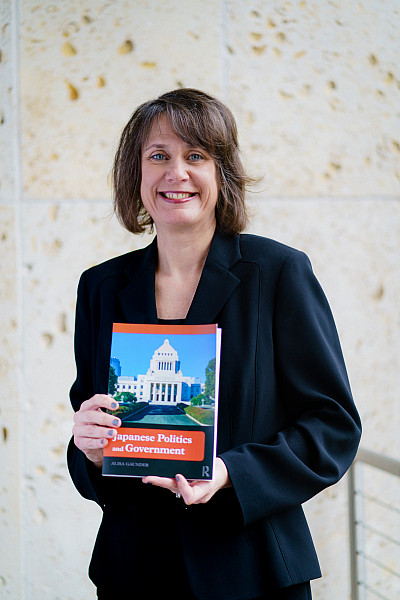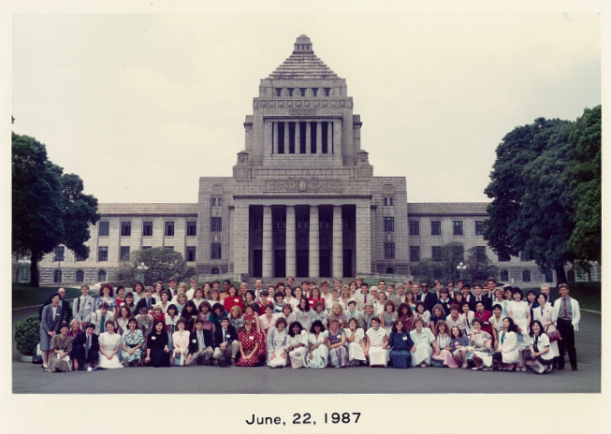News
Cover of Japanese Politics and Government Has Special Meaning to its Author, Southwestern University Dean of the Faculty Dr. Alisa Gaunder
February 26, 2018
February 26, 2018

Many authors can relate to the challenge of choosing a cover that best represents the contents of their book. After hours of careful research and writing, they then agonize over the final cover. Which makes sense, because first impressions have a lasting impact.
Dr. Alisa Gaunder, Dean of the Faculty at Southwestern University, recently went through this decision process when choosing the cover of her latest book, Japanese Politics and Government.
The book investigates Japanese politics in the postwar era from theoretical and comparative perspectives, offers an in-depth exploration of postwar political institutions, political reform in the 1990s, the policymaking process, and the politics of economic growth and stagnation.
Gaunder is widely known as an expert in the field of Japanese politics. She received her doctorate in political science, specializing in comparative politics and Japan, from the University of California, Berkeley. She is also the author of Political Reform in Japan: Leadership Looming Large (Routledge 2007) and the editor of The Routledge Handbook of Japanese Politics (Routledge 2011).
For the cover of her latest book, she went back and forth on several options, but in the end chose a beautiful picture of the National Diet Building in Tokyo, where both houses of the Japanese Parliament meet. It is a gorgeous and classic shot that represents the contents of the book, but there is personal meaning as well. The National Diet Building holds many special memories for Gaunder, dating back to her very first visit to Japan.
“I didn’t choose Japan. Japan Chose Me.”
Gaunder’s interest in Japan started somewhat by chance. A high school student in Florence, Alabama, she heard about a summer program by Youth for Understanding designed to encourage U.S. high school students to develop an interest in politics and government. On a whim she applied to the program and was offered one of two available spots from her state to travel to Japan. She had never been and didn’t know much about the country (even admits she didn’t even like sushi!), but she yearned for adventure and new experiences. The program gave her that and more.
She saw the Diet Building her very first day in Japan - an impressive introduction to the country!

Gaunder’s first visit to Japan was eye-opening. She lived with a host family and fell in love with the people and culture, although the language barrier was a challenge. She felt that not being able to speak Japanese kept her learning and understanding at a surface level. It was a wonderful experience, but she wanted to go more in depth.
Returning to Japan
The next time she saw the building, Gaunder was a college student at Washington University in St. Louis. Determined to learn the language and be able to communicate with her host family and the friends that she’d made, she took Japanese in college and studied a year abroad in Tokyo. She immersed herself in the culture.
Not only did her Japanese language skills grow, but so did her interest in Japanese politics. Gaunder was particularly fascinated with modern, post WWII Japan. She applied for and won a Fulbright Scholarship to study politics in the country after graduation. But before she left, she completed a summer internship for Congressman Howell Heflin in Alabama.
Doing these two internships back-to-back gave her a unique perspective on the differences between the two governments. She compared the Presidential structure of the United States versus the Parliamentary structure of Japan, which again sparked an interest in digging deeper to better understand the complexities involved. She was so intrigued with Japanese comparative politics that she dedicated her graduate studies to the subject. Gaunder received both her masters and doctorate in political science, specializing in comparative politics and Japan, from the University of California, Berkeley.
Full Circle
In 2005, Gaunder return to Japan, this time hosting a group of students for a political leadership program. She saw some of the same politicians that she had worked for twelve years earlier, and introduced her students to the culture and politics she had grown to love. And yes, of course she took pictures with these students in front on the historic National Diet Building.
Today
Gaunder continues to research and write on Japanese politics. In addition to Japanese Politics and Government, she recently authored an article titled “‘Madonnas,’ ‘Assasins,’ and ‘Girls’’: How Female Politicians Respond to Media Labels Reflecting Party Leader Strategy, in the U.S.-Japan Women’s Journal discussing how media covers female politicians in Japan. As the Dean of the Faculty, Gaunder has a full plate, but believes that it’s important to continue researching and writing and modeling the teacher-scholar model. “I feel grateful that the institution supports my research, and writing keeps me energized and engaged.”
Japanese Politics and Government is used by upper-level political science students to study Japanese politics in the postwar era. Some of them may travel to see the Diet Building, making memories of their own.
For Gaunder, the building has stood the test of time. It was there when her initial interest in Japan was sparked, and has remained a symbol of her interest, work and studies through today.
For more info on Dr. Gaunder’s work in the area of Japanese Politics click here.















